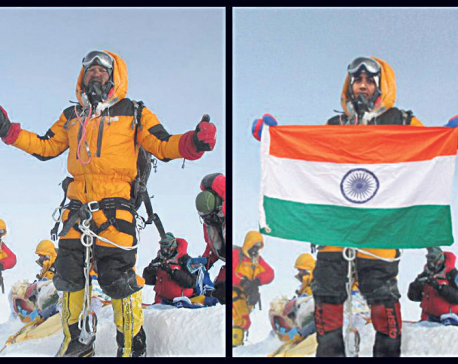
OR
New Everest season
Part of the charm of climbing Mount Everest has always been the danger associated with the herculean endeavor. With plenty of steep slopes and deep gorges, and the always imminent likelihood of unplanned snow storms, there is always an element of risk. This year, six people have already perished while trying to climb the tallest mountain in the world. But to put that into perspective, this climbing season, over 200 have successfully ascended Everest, with many more lining up to do so in the next few weeks. This season, the Department of Tourism has issued a record 372 permits to climb Everest, the highest since the first ascent of Everest in 1953. History suggests that as the number of climbers grows, so will the fatalities, even though the vast majority of climbers will make it up and down safe and sound. But if the news of the collapse of the famous Hillary Step—the sheer rock face just below the summit of Everest—is true opinion is divided if that will facilitate the climb or make it more dangerous. Some are already attributing the fatalities this year to the purported collapse of Hillary Step.
There are other areas of concern. With the number of climbers wanting to scale Everest increasing (as the memories of the devastating earthquakes in 2015 fade), pollution on Everest could get worse. Every climbing season, over 12,000 kg of human excreta is generated by climbers, and most of it is carelessly dumped. Then there are tons and tons of garbage comprised of discarded cylinders, ropes, beer cans, plastic containers, and tragically, the uncollected bodies of unfortunate climbers. Considering the alarming level of pollution, Nepal in 2014 made it mandatory for all climbers to bring back at least eight kg of rubbish, in addition to the waste they themselves generate. Before that there was a system of a deposit of US $4,000 per climber, which they would forfeit if they didn’t bring back the waste they generated. But this had limited impact on pollution control. It is too early to evaluate the success of the new measure of compulsorily bringing back certain amount of rubbish. What is indisputable is that even if this measure works it will take many years to clean up Everest.
Concerns about the alarming depletion of ice levels in our mountains due to climate change are also growing. As ice melts, the habitable communities downstream will be at great risk of floods. Nepal and other countries along the Himalayas have not been able to forcefully raise this life-and-death issue at the international climate summits. We also get to hear of ‘traffic jams’ on Mount Everest resulting from the record number of climbers, as the government and the trekking agencies continue to see Everest as a perennial cash cow. The government each year collects around $3.5 in Everest climbing fees, and climbers additionally spend thousands of dollars on climbing kits and in securing the services of the Sherpas to carry their luggage. Abruptly stopping all climbs could disrupt the livelihoods of thousands, while also deterring countless adventure travelers from coming to Nepal. Yet it is also difficult to strike the right balance between saving the mountain and benefitting from it commercially. The task will get trickier still as the effects of climate change become more prominent and as more people pursue the ultimate adventure of scaling Everest. We have no option but to keep trying to get that balance right.
You May Like This

Oil edges down after expected climb in U.S. output
Oil prices fell in thin trade on Tuesday after the Easter holiday break shut many markets for as long as... Read More...

Firmino on target as Liverpool climb to third
Liverpool reclaimed third spot in the Premier League after Roberto Firmino's header sealed a hard-fought 1-0 victory against West Bromwich... Read More...

Nepal bans Indian police couple for faking Everest climb
KATHMANDU, Aug 30: Nepal has imposed a 10-year mountaineering ban on an Indian couple who faked photographs purporting to show... Read More...




Just In
- Govt receives 1,658 proposals for startup loans; Minimum of 50 points required for eligibility
- Unified Socialist leader Sodari appointed Sudurpaschim CM
- One Nepali dies in UAE flood
- Madhesh Province CM Yadav expands cabinet
- 12-hour OPD service at Damauli Hospital from Thursday
- Lawmaker Dr Sharma provides Rs 2 million to children's hospital
- BFIs' lending to private sector increases by only 4.3 percent to Rs 5.087 trillion in first eight months of current FY
- NEPSE nosedives 19.56 points; daily turnover falls to Rs 2.09 billion















Leave A Comment